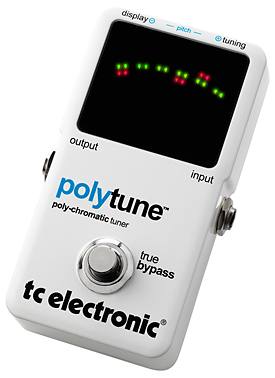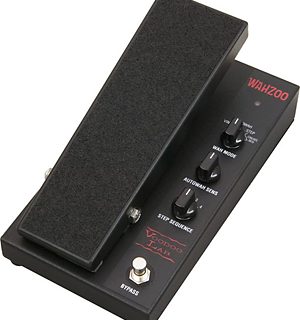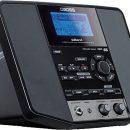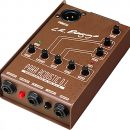People at the Winter NAMM show were pretty excited about this little white box. While another company was busy introducing an update to their famously popular tuner pedal, TC Electronic was showing off a new tuner of their own — the revolutionary polytune poly-chromatic tuner.
| Category | Value | Rating |
| Features | 20% | |
| Usability | 25% | |
| Sound | 25% | |
| Documentation & Support | 10% | |
| Price | 20% | |
| OVERALL RATING = 3.3 3.6 stars or better: Outstanding, WIHO Award 3 stars or better: Worth considering 2 stars or better: Suited to specific needs 1 star or less: Not recommended |
||
What makes this tuner revolutionary, of course, is the fact that it is poly-chromatic, providing the ability to tune all strings concurrently! Strum all six strings open and the display shows which individual strings are sharp, flat, and on pitch. And yes, it works for bass players, too!
Our initial impression was extremely positive — the polytune does a good job of tuning in a manner that has never been accomplished before, provided you stick to standard tunings. It can also tune strings individually the “old fashioned” way, and you need to use this traditional method of tuning when dealing with alternate and/or dropped tunings, or guitars with seven or eight strings. We also appreciated that it features true bypass circuitry!
However, we have to issue a big word of caution if you plan to use the polytune to power your other pedals. As with other tuner pedals, the polytune can power a chain of additional pedals, but it took very little effort for us to destroy one of our beloved pedals that was accidentally fed some extra power that it couldn’t handle.
Features
The polytune comes nicely wrapped in a compact, metal enclosure with a Carling-style bypass/tune footswitch, and it can operate on either a 9V battery or via a power adapter (not supplied). When not in use (bypassed), the polytune provides true bypass, completely removed from your signal path without a buffer.
The cool looking display features red and green colored LEDs, and the display changes automatically from one mode of operation to another whether you strum an open guitar or play an individual note for tuning.
In poly-chromatic mode, the display shows all of the strings by note name, and red and green LED indicators show which notes are flat or sharp (see the photo above).
The polytune is designed for traditional six-string guitars and basses, and the display shows as many as six strings when used in the poly-chromatic mode. If you’re using a seven-string guitar (or one of those crazy eights), you’ll have to forego this clever tuning mode and rely upon the traditional chromatic tuning modes as the display can’t fit the extra strings.
In chromatic mode (which is displayed automatically when you hit an individual note), the display features a familiar, but customizable, interface. Above the letter note value, the default Needle mode shows a virtual needle with sharp and flat indicators to the left and right. The needle moves as you adjust tuning.
Alternately, you can change the display to Stream mode via a recessed button on the rear of the tuner. This mode should be familiar to anyone who has worked with a stroboscopic tuner. In this mode, the stream of LEDs move right or left, faster or slower as you approach the desired pitch. When the LEDs stop moving, you’re in tune.
The other recessed button on the rear of the polytune is used for configuring the tuner to be used with dropped tunings. Tuning can be dropped up to five semitones. Note that this drop occurs across the entire guitar, so if you tune everything down a half-step, whole step, or more, you’ll be able to take advantage of the poly-chromatic tuning mode.
Tip: If you’re just dropping your low E string for drop-D or drop-C tuning, you’ll want to leave the tuning set for standard operation and tune your low string via the chromatic mode.
Playing with an orchestra? No problem. The default pitch reference of A 440 Hz can be set anywhere from 435 to 445 Hz in one Hz increments.
When the polytune is powered from an external power supply, you can chain multiple pedals to its Power Out connector in order to provide power to your other effects. Those pedals can draw up to 2 Amps of current (2000mA). For reference, the polytune itself draws 45mA of current, so this should be enough capacity to power an assortment of pedals once you obtain a suitable daisy chain power cable.
If you’re running from a 9V battery, the input jack starts the flow of power — remember to unplug from this jack when you’re not playing to preserve battery life.
A USB port on the rear of the tuner is reserved for service and possible software updates — there is no end-user feature related to computer connectivity here.
Usability
The polytune is just as easy to use as any other tuner pedal available. It was easy for us to make full use of its capabilities whether tuning in poly-chromatic or chromatic modes. We tested with a variety of six-string electric guitars and a five-string bass. There’s not much we can really say about the polytune other than this: the revolutionary product worked as advertised!
Battery users will appreciate the rear screw-on cover — any coin will give you access to the battery compartment (or a guitar pick if you don’t screw it in too tightly). We also appreciated that TC Electronic thoughtfully included two pieces of pre-cut Velcro to attach the tuner to our pedalboard.
Unfortunately, players with guitars that feature the Buzz Feiten Tuning System or comparable compensated systems will have to stick to the chromatic tuning mode — or use their compensated rack tuners. Tuning our Suhr Modern in the poly-chromatic mode rendered it noticeably out of tune (as would any traditional tuner if you tuned open strings on a BFTS-equipped guitar). Of course, tuning each string to E at the appropriate fret or harmonic on this guitar yielded accurate tuning results.
We appreciated that while strumming chords, the polytune tracked the pitch of our notes. This wasn’t relevant for tuning, but while experimenting with new chord fingerings, it was handy to see the basic chord note on the display. You’ll have to decide for yourself whether you’re playing major, minor, etc…
Be careful when connecting the polytune to an external power supply! The documentation isn’t nearly explicit enough regarding what power supplies to use, or proper daisy chaining of pedals in the power chain.
The documentation specifies to use any 9V DC power supply with the center wired to ground (negative). We connected a BOSS PSA power supply (9.6 V, technically) and it worked great, both powering the tuner and another pedal that we connected using a daisy-chain power cable.
Trouble came when we mistakenly used our Line 6 PX-2 power supply, which is used to power popular four-pedal modeler pedals like the DL-4. The pedal actually provides 9V AC — not DC, and polarity is wired in reverse. However, to protect other equipment, that power supply senses when it is connected inappropriately to DC-hungry gear and it adjusts the power output appropriately. As a result, the Line 6 power supply actually worked fine powering the polytune on its own.
However, when we connected a BOSS chorus pedals to the power daisy chain, the tuner pedal stopped functioning (temporarily) and our chorus pedal blew up! We can still smell the burnt circuits in our studio while writing this. Once we disconnected the devastated pedal from the signal chain, the polytune resumed functioning properly.
We think a warning needs to be provided in the documentation and/or in the usually-helpful knowledgebase on the TC Electronic website — Line 6 pedals are far too common for us to be the only people who will end up destroying some pedals. But now you know — make sure you’re connecting the correct 9V DC power supply!
Sound
The polytune is a transparent addition to your pedalboard. The true bypass circuitry works as expected, and our signal sounded the same bypassing the tuner as it did with a cable straight into the front of our amp.
Documentation and Product Support
The polytune includes a simple guide to operations that covers all of its features. Obviously, it does not provide adequate warnings regarding selection of power supplies and providing power to additional pedals. Be careful!
Price
The TC Electronic polytune (MSRP $149) typically sells for $99, a very good price for a feature-rich tuner with the benefit of true bypass. If a tuner on the pedalboard is your ticket to accurate tuning, you can’t go wrong here, even if you plan to stick to tuning the old fashioned way, one string at a time.
Contact Information
TC Electronic
www.tcelectronic.com
| Evaluation Short-List |
|

















